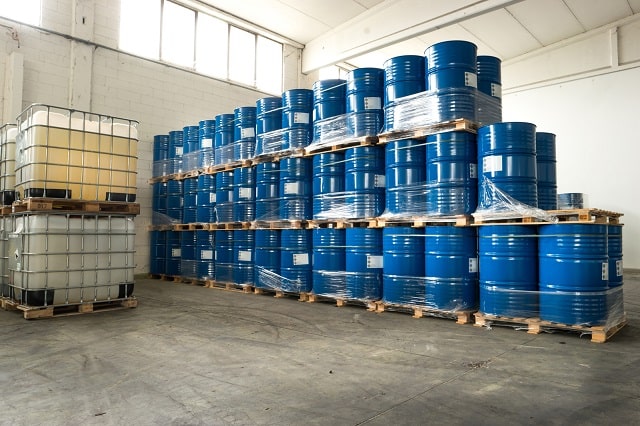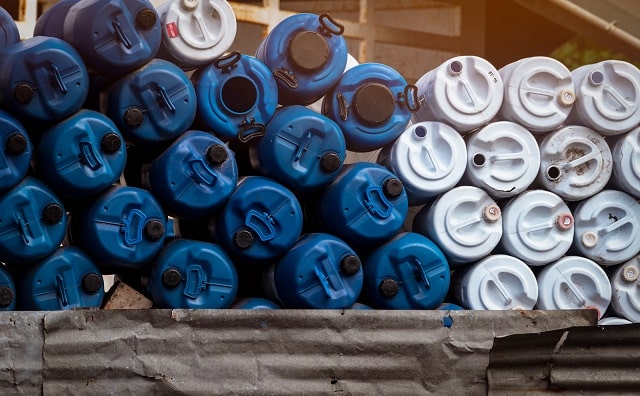Totes, also called intermediate bulk containers (IBCs), are used to transport large quantities of raw materials and finished goods worldwide. These containers are especially important for the transportation of chemicals as they can be customized to meet material compatibility requirements and reused for multiple trips. Chemical totes often contain an inner liner that’s constructed of a fluoropolymer or other material that can provide excellent resistance to the materials that will be transported inside.
One of the most important factors to consider when introducing a fleet of chemical totes is establishing strong protocols for asset tracking. Chemical totes are designed to be rugged and often represent a significant investment for an organization. In this post, we’ll discuss 5 ways that you can improve your chemical tote tracking processes. Many of these recommendations are derived from chemical inventory management best practices that can add significant value to your operation by reducing costs and improving the efficiency of tote handling. Given the large quantities of chemicals that are stored and shipped using totes, it’s important to establish clear operating parameters and guidelines for your employees, customers, and logistics partners.

An effective tracking system should contain a complete electronic record for each asset. It may also be helpful to examine your software settings and add custom fields for routine information that is entered for totes. Keeping an accurate inventory of chemical lot numbers and tote serial numbers makes it much easier to find important data, such as safety data sheets, when required. Another important tip is to use a unique serial number for each tote and conduct regular asset audits to identify errors. Your electronic record can also serve as a chain of custody for each tote, making it easy to verify the location and status of each asset.
It’s important to select and configure your asset tracking hardware and software systems in a way that makes them highly adaptable and scalable. As businesses grow, they often become increasingly complex, and it’s usually a good idea to upgrade your infrastructure as soon as possible. This is especially true if your current systems are slow, lack integration with other platforms, or cannot meet your key performance indicator (KPI) reporting needs. Today’s cloud-based platforms are an excellent resource for tracking chemical totes when paired with durable asset tags. Metalphoto® asset tags are particularly beneficial for tracking chemical totes, as they have the durability to withstand harsh indoor and outdoor environmental conditions and offer an expected lifespan of more than 20 years. An effective asset tracking system should give you access to the information you need at any time.

Because chemical totes may be stored in warehouses, factories, and customer sites, maintaining an accurate IBC inventory at all times is crucial. This is especially true for containers that are stored at customer sites. A failure to count these totes could result in lost containers and a significant cost for replacement. It’s possible to compile a complete tote inventory by working with the sales and logistics teams to compare quantities in the field to those captured in your inventory management system.
An asset tracking system can also be used to improve the efficiency of your existing chemical tote processing workflows. Take time to fully understand the capabilities of your asset management system to determine if automation, machine learning, and AI tools can be used. In some cases, these capabilities can significantly improve workflows and make it easier for employees to complete basic tasks related to the filling, storage, and shipment of totes. Your asset control system also helps you monitor the status containers stored at each location that you are managing.
When using an asset and inventory management system to track totes, you should also configure your reporting to maximize the value of the associated data. Most operations will track a customized selection of key performance indicators to monitor the status of key workflows. It’s vital to have visibility into all important areas, and most asset management platforms contain custom reporting features. Sharing data with employees at all levels helps keep everyone aligned and focused on results. Choose a complete reporting setup that meets your needs and is intuitive to manage.
Chemical tote tracking is used to manage assets in many sectors such as pharmaceuticals, chemical distribution, and food processing. Bulk containers are a necessary resource for any operation that needs to routinely transport large quantities of chemicals at a reasonable cost. By using asset tracking technology and inventory management best practices, it’s possible to maximize the useful life of chemical totes. This ultimately helps you control business costs and can have a positive impact on the profitability and reliability of chemical management operations.
Our sales engineers are experts in automatic asset tracking, tagging and identification,a nd can answer all your questions. Get in touch now.
Lets Talk ›